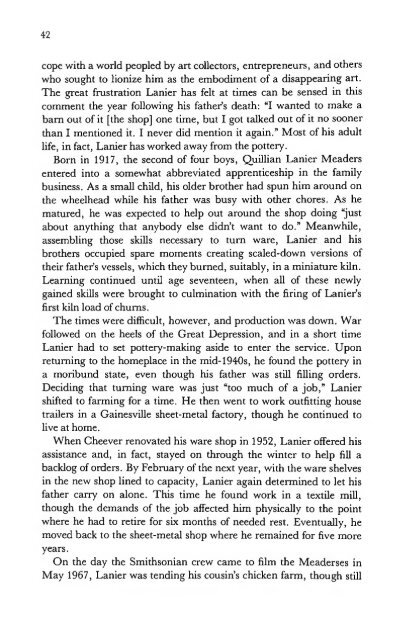Smithsonian Contributions - Smithsonian Institution Libraries
Smithsonian Contributions - Smithsonian Institution Libraries
Smithsonian Contributions - Smithsonian Institution Libraries
Create successful ePaper yourself
Turn your PDF publications into a flip-book with our unique Google optimized e-Paper software.
42<br />
cope wim a world peopled by art collectors, entrepreneurs, and others<br />
who sought to lionize him as the embodiment of a disappearing art.<br />
The great frustration Lanier has felt at times can be sensed in this<br />
comment the year following his fadier's death: "I wanted to make a<br />
barn out of it [the shop] one time, but I got talked out of it no sooner<br />
than I mentioned it. I never did mention it again." Most of his adult<br />
life, in fact, Lanier has worked away from the pottery.<br />
Born in 1917, the second of four boys, Quillian Lanier Meaders<br />
entered into a somewhat abbreviated apprenticeship in the family<br />
business. As a small child, his older brother had spun him around on<br />
the wheelhead while his father was busy with other chores. As he<br />
matured, he was expected to help out around the shop doing "just<br />
about anything diat anybody else didn't want to do." Meanwhile,<br />
assembling those skills necessary to turn ware, Lanier and his<br />
brothers occupied spare moments creating scaled-down versions of<br />
their father's vessels, which they burned, suitably, in a miniature kiln.<br />
Learning continued until age seventeen, when all of these newly<br />
gained skills were brought to culmination with the firing of Lanier^<br />
first kiln load of churns.<br />
The times were difficult, however, and production was down. War<br />
followed on the heels of the Great Depression, and in a short time<br />
Lanier had to set pottery-making aside to enter the service. Upon<br />
returning to the homeplace in the mid-1940s, he found the pottery in<br />
a moribund state, even though his father was still filling orders.<br />
Deciding that turning ware was just "too much of a job," Lanier<br />
shifted to farming for a time. He then went to work outfitting house<br />
trailers in a Gainesville sheet-metal factory, though he continued to<br />
live at home.<br />
When Cheever renovated his ware shop in 1952, Lanier offered his<br />
assistance and, in fact, stayed on through the winter to help fill a<br />
backlog of orders. By February of the next year, with the ware shelves<br />
in the new shop lined to capacity, Lanier again determined to let his<br />
father carry on alone. This time he found work in a textile mill,<br />
though the demands of the job affected him physically to the point<br />
where he had to retire for six months of needed rest. Eventually, he<br />
moved back to the sheet-metal shop where he remained for five more<br />
years.<br />
On the day the <strong>Smithsonian</strong> crew came to film the Meaderses in<br />
May 1967, Lanier was tending his cousin's chicken farm, though still

















